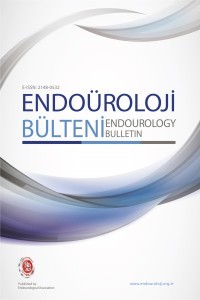İdrar Taşlarının Kimyasal Bileşiminin Kontrastsız Helikal Bilgisayarlı Tomografi ile In Vivo Değerlendirilmesi
Stone, density, tomography, dual, hounsfield unit
In Vivo Evaluation of The Chemical Composition of Urinary Stones Using Non-Contrast Helical Computerized Tomography
Stone, density, tomography, dual, hounsfield unit,
___
- 1. Romero V, Akpinar H, Assimos DG (2010); Kidney stones: a global picture of prevalence, incidence, and associated risk factors. Rev Urol Spring-Summer 12 (2-3) e86–e962.
- 2. Matlaga BR, Kawamoto S, Fishman E (2008), Dual Source Computed Tomography: A Novel Technique to Determine Stone Composition, Urology 72(5):1164-8., https://doi.org/10.1016/j.urology.2008.03.051
- 3. Hassani H, Raynal G, Spie R, Daudon M, Vallée JN (2012) Imaging-based assessment of the mineral composition of urinary stones: an in vitro study of the combination of hounsfield unit measurement in noncontrast helical computerized tomography and the twinkling artifact in color Doppler ultrasound. Ultrasound Med Biol 38(5):803-10., https://doi.org/10.1016/j.ultrasmedbio.2012.01.009
- 4. Marchini GS et.al. (2013); Stone characteristics on noncontrast computed tomography: establishing definitive patterns to discriminate calcium and uric acid compositions. Urology 82(3):539-46., https://doi.org/10.1016/j.urology.2013.03.092
- 5. Ito H et.al. (2012); Predictive value of attenuation coefficients measured as Hounsfield units on noncontrast computed tomography during flexible ureteroscopy with holmium laser lithotripsy: a single-center experience. J Endourol 26(9):1125-30., https://doi.org/10.1089/end.2012.0154
- 6. Perks AE, Gotto G, Teichman JM (2007); Shock wave lithotripsy correlates with stone density on preoperative computerized tomography. J Urol 178(3Pt1):912-5., https://doi.org/10.1016/j.juro.2007.05.043
- 7. Deveci S, Coşkun M, Tekin MI, Peşkircioglu L, Tarhan NC, Ozkardeş H (2004); Spiral computed tomography: role in determination of chemical compositions of pure and mixed urinary stones--an in vitro study. Urology 64(2):237-40., https://doi.org/10.1016/j.urology.2004.03.029
- 8. Smith RC et.al. (1995); Acute flank pain: comparison of non-contrast-enhanced CT and intravenous urography. Radiology 194(3):789-94., https://doi.org/10.1148/radiology.194.3.7862980
- 9. Manglaviti G et.al. (2011); In vivo evaluation of the chemical composition of urinary stones using dual-energy CT. AJR Am J Roentgenol 197(1): W76-83., https://doi.org/10.2214/AJR.10.5217
- 10. Demirel A, Suma S (2003); The efficacy of non-contrast helical computed tomography in the prediction of urinary stone composition in vivo. J Int Med Res 31(1):1-5., https://doi.org/10.1177/147323000303100101
- 11. El-Assmy A, Abou-el-Ghar ME, el-Nahas AR, Refaie HF, Sheir KZ (2011); Multidetector computed tomography: role in determination of urinary stones composition and disintegration with extracorporeal shock wave lithotripsy--an in vitro study. Urology 77(2):286-90., https://doi.org/10.1016/j.urology.2010.05.021
- 12. Hidas G et.al. (2010); Determination of renal stone composition with dual-energy CT: in vivo analysis and comparison with x-ray diffraction. Radiology 257(2):394-401., https://doi.org/10.1148/radiol.10100249
- 13. Wisenbaugh ES, Paden RG, Silva AC, Humphreys MR (2014); Dual-energy vs conventional computed tomography in determining stone composition. Urology Jun;83(6):1243-7., https://doi.org/10.1016/j.urology.2013.12.023
- 14. Hasan Erdogan, MD., Osman Temizoz, MD., Mustafa Koplay, MD., and Bahadir Ozturk, MD.; In Vivo Analysis of Urinary Stones With Dual-Energy Computed Tomography, J Comput Assist Tomogr 2019;43: 214–219, https://doi.org/10.1097/RCT.0000000000000831
- 15. Mostafavi MR, Ernst RD, Saltzman B (1998); Accurate determination of chemical composition of urinary calculiby spiral computerized tomography. J Urol. 159:673-675.
- 16. Saw KC et.al. (2000); Calcium stone fragility is predicted by helical CT attenuation values. J Endourol. 14(6):471-4., https://doi.org/10.1089/end.2000.14.471
- 17. Bellin MF et.al. (2004); Helical CT evaluation of the chemical composition of urinary tract calculi with a discriminant analysis of CT-attenuation values and density. Eur Radiol. 14(11):2134-40., https://doi.org/10.1007/s00330-004-2365-6
- 18. Grosjean R et.al. (2013); Pitfalls in urinary stone identification using CT attenuation values: are we getting the same information on different scanner models? Eur J Radiol 82(8):1201-6., https://doi.org/10.1016/j.ejrad.2013.02.020
- 19. Williams JC Jr, Saw KC, Monga AG, Chua GT, Lingeman JE, McAteer JA (2001) Correction of helical CT attenuation values with wide beam collimation: in vitro test with urinary calculi. Acad Radiol 8(6):478-83., https://doi.org/10.1016/S1076-6332(03)80619-0
- 20. Motley G, Dalrymple N, Keesling C, Fischer J, Harmon W (2001); Hounsfield unit density in the determination of urinary stone composition. Urology 58(2):170-3., https://doi.org/10.1016/S0090-4295(01)01115-3
- 21. Stewart G et.al. (2015); Stone size limits the use of hounsfield units prediction of calcium oxalate stone composition. Urology 85(2):292-4., https://doi.org/10.1016/j.urology.2014.10.006
- Yayın Aralığı: Yılda 3 Sayı
- Başlangıç: 2020
- Yayıncı: ENDOÜROLOJİ DERNEĞİ
Pelvimetrik Ölçümlerin Açık Retropubik Radikal Prostatektomi Operasyon Süresi Üzerine Etkileri
Mustafa AYDIN, Lokman İRKİLATA, Mustafa Koray KIRDAĞ, Uğur ÖZTÜRK, Mehmet ÖZEN, Emrah KÜÇÜK, Hakan YILDIZ, Reha ORDULU, Mustafa Kemal ATİLLA
Osman Raif KARABACAK, Fatih SANDIKÇI, Hakan SALTAŞ, Alper DİLLİ, Kürşad ZENGİN, Fatih YALÇINKAYA, Ümit Yaşar AYAZ
Harun ÖZDEMİR, Emin Taha KESKİN, Merve ŞAM ÖZDEMİR, Metin SAVUN, Halil Lütfi CANAT, Abdülmüttalip ŞİMŞEK
Perkütan Nefrolitotomi Ameliyatında Taşsızlığın İntraoperatif Değerlendirilmesi: Cerrahın Gözü
Mehmet Yiğit YALÇIN, Batuhan ERGANİ, Taha ÇETİN, Mustafa KARABIÇAK, Mert Hamza ÖZBİLEN, Çağdaş BİLDİRİCİ, Erkin KARACA, Mehmet YOLDAŞ, Erdem KISA, Tufan Suel ÖZGEN, Gökhan KOÇ, Özgür ÇAKMAK, Hayal BOYACIOĞLU, Yusuf Özlem İLBEY
